Oscillatory Motion and Waves and Physics of Hearing.
125 Superposition and Interference
Learning Objectives
- Explain how superposition leads to standing waves and beats.
- Describe the mathematical basis for overtones and beat frequency.

Waves in nature often appear much more complex than simple sinusoidal shapes. As shown in Figure 125.1, most waveforms result from the combination—or superposition—of many individual waves. Despite their complexity, these waves follow straightforward rules. When two or more waves meet at a point in space, their displacements add algebraically.
For waves that overlap exactly in phase, their amplitudes combine to produce constructive interference. An example is shown in Figure 125.2, where two identical waves align crest-to-crest and trough-to-trough, resulting in a wave with twice the amplitude.
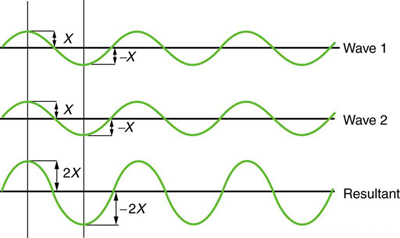
In contrast, Figure 125.3 shows destructive interference, where the crest of one wave aligns with the trough of another. Their displacements cancel out, producing zero net amplitude.
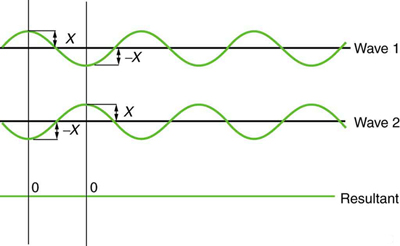
Most wave interactions involve partial alignment, producing a mix of constructive and destructive interference across different locations or times. For example, in a room with multiple audio speakers, certain regions may sound louder due to constructive interference, while others sound muted due to destructive interference.
When waves of different shapes and frequencies combine, the resulting waveform becomes more irregular, as shown in Figure 125.4.
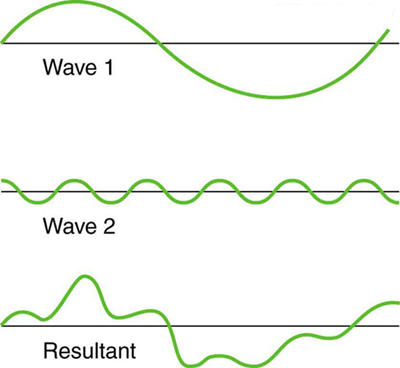
Standing Waves
Sometimes waves appear stationary even though they result from moving disturbances. These are called standing waves, created by the superposition of two identical waves traveling in opposite directions. A familiar example is the vibration of fluid surfaces in a container, such as milk in a refrigerator. Standing waves also occur in strings, like those on musical instruments.
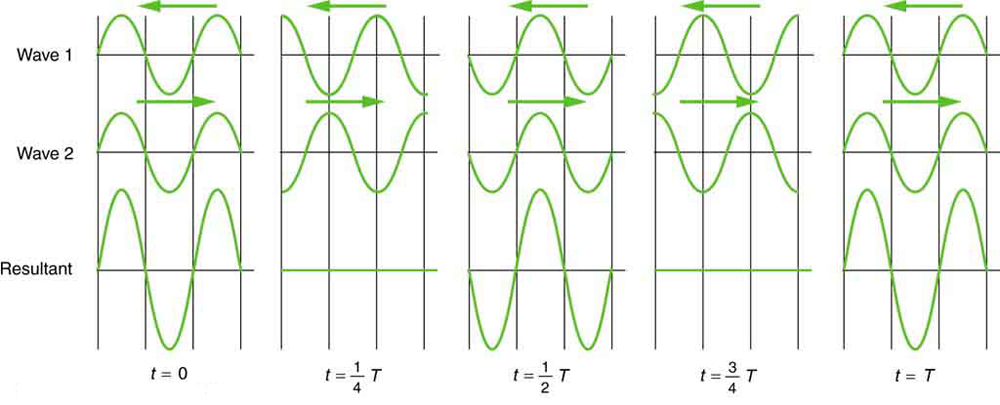
In standing waves, fixed points called nodes remain stationary, while the points of maximum motion are known as antinodes. Strings fixed at both ends form standing waves with quantized frequencies. The fundamental, or lowest frequency, corresponds to the longest wavelength:
Higher-frequency modes are called harmonics or overtones. The second harmonic (first overtone) has half the wavelength of the fundamental:
And the third harmonic:
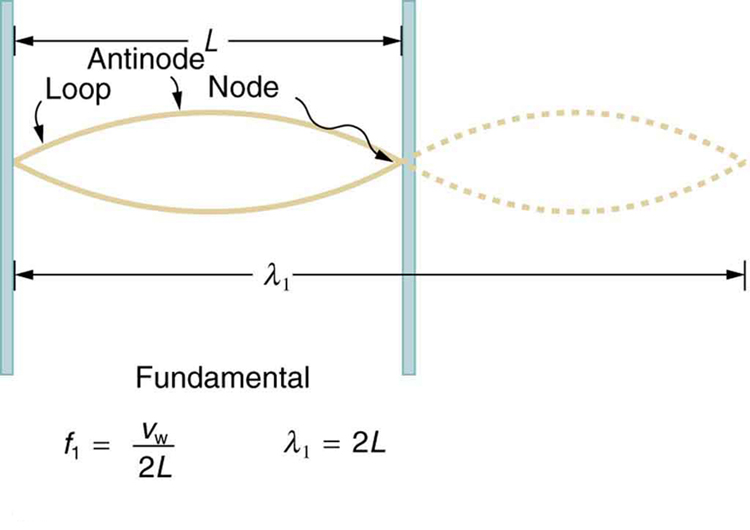
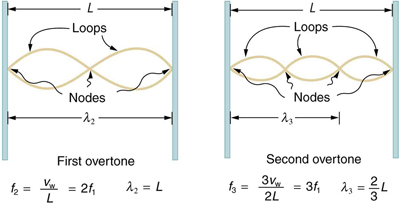
Beats
When two sound waves of similar frequency are combined, the result is a wave whose amplitude varies periodically. This phenomenon is known as a beat. Listeners perceive the volume fluctuating—an effect often heard when tuning musical instruments or listening to two closely pitched jet engines.

The general form for a wave of frequency [latex]f[/latex] is:
If we add two such waves with frequencies [latex]f_1[/latex] and [latex]f_2[/latex], the result is:
Using a trigonometric identity:
where:
The result is a wave with an average frequency and a slowly varying amplitude at the beat frequency [latex]f_B[/latex]. This phenomenon is useful in a range of applications, including sound tuning, radar, and ultrasound imaging.
Making Career Connections
Piano tuners use beats routinely in their work. When comparing a note with a tuning fork, they listen for beats and adjust the string until the beats go away (to zero frequency). For example, if the tuning fork has a [latex]\text{256}\phantom{\rule{0.25em}{0ex}}\text{Hz}[/latex] frequency and two beats per second are heard, then the other frequency is either [latex]\text{254}[/latex] or [latex]\text{258}\phantom{\rule{0.25em}{0ex}}\text{Hz}[/latex]. Most keys hit multiple strings, and these strings are actually adjusted until they have nearly the same frequency and give a slow beat for richness. Twelve-string guitars and mandolins are also tuned using beats.
While beats may sometimes be annoying in audible sounds, we will find that beats have many applications. Observing beats is a very useful way to compare similar frequencies. There are applications of beats as apparently disparate as in ultrasonic imaging and radar speed traps.
Imagine you are holding one end of a jump rope, and your friend holds the other. If your friend holds her end still, you can move your end up and down, creating a transverse wave. If your friend then begins to move her end up and down, generating a wave in the opposite direction, what resultant wave forms would you expect to see in the jump rope?
The rope would alternate between having waves with amplitudes two times the original amplitude and reaching equilibrium with no amplitude at all. The wavelengths will result in both constructive and destructive interference
Check Your Understanding
Define nodes and antinodes.
Nodes are areas of wave interference where there is no motion. Antinodes are areas of wave interference where the motion is at its maximum point.
You hook up a stereo system. When you test the system, you notice that in one corner of the room, the sounds seem dull. In another area, the sounds seem excessively loud. Describe how the sound moving about the room could result in these effects.
With multiple speakers putting out sounds into the room, and these sounds bouncing off walls, there is bound to be some wave interference. In the dull areas, the interference is probably mostly destructive. In the louder areas, the interference is probably mostly constructive.
PhET Explorations: Wave Interference
Make waves with a dripping faucet, audio speaker, or laser! Add a second source or a pair of slits to create an interference pattern.
Section Summary
- Superposition is the combination of two waves at the same location.
- Constructive interference occurs when two identical waves are superimposed in phase.
- Destructive interference occurs when two identical waves are superimposed exactly out of phase.
- A standing wave is one in which two waves superimpose to produce a wave that varies in amplitude but does not propagate.
- Nodes are points of no motion in standing waves.
- An antinode is the location of maximum amplitude of a standing wave.
- Waves on a string are resonant standing waves with a fundamental frequency and can occur at higher multiples of the fundamental, called overtones or harmonics.
- Beats occur when waves of similar frequencies [latex]{f}_{1}[/latex] and [latex]{f}_{2}[/latex] are superimposed. The resulting amplitude oscillates with a beat frequency given by
[latex]{f}_{\text{B}}=\mid {f}_{1}-{f}_{2}\mid .[/latex]
Conceptual Questions
- Speakers in stereo systems have two color-coded terminals to indicate how to hook up the wires. If the wires are reversed, the speaker moves in a direction opposite that of a properly connected speaker. Explain why it is important to have both speakers connected the same way.
Problems & Exercises
- A car has two horns, one emitting a frequency of 199 Hz and the other emitting a frequency of 203 Hz. What beat frequency do they produce?
- The middle-C hammer of a piano hits two strings, producing beats of 1.50 Hz. One of the strings is tuned to 260.00 Hz. What frequencies could the other string have?
- Two tuning forks having frequencies of 460 and 464 Hz are struck simultaneously. What average frequency will you hear, and what will the beat frequency be?
- Twin jet engines on an airplane are producing an average sound frequency of 4100 Hz with a beat frequency of 0.500 Hz. What are their individual frequencies?
- A wave traveling on a Slinky® that is stretched to 4 m takes 2.4 s to travel the length of the Slinky and back again. (a) What is the speed of the wave? (b) Using the same Slinky stretched to the same length, a standing wave is created which consists of three antinodes and four nodes. At what frequency must the Slinky be oscillating?
- Three adjacent keys on a piano (F, F-sharp, and G) are struck simultaneously, producing frequencies of 349, 370, and 392 Hz. What beat frequencies are produced by this discordant combination?
Glossary
- antinode
- the location of maximum amplitude in standing waves
- beat frequency
- the frequency of the amplitude fluctuations of a wave
- constructive interference
- when two waves arrive at the same point exactly in phase; that is, the crests of the two waves are precisely aligned, as are the troughs
- destructive interference
- when two identical waves arrive at the same point exactly out of phase; that is, precisely aligned crest to trough
- fundamental frequency
- the lowest frequency of a periodic waveform
- nodes
- the points where the string does not move; more generally, nodes are where the wave disturbance is zero in a standing wave
- overtones
- multiples of the fundamental frequency of a sound
- superposition
- the phenomenon that occurs when two or more waves arrive at the same point
the phenomenon that occurs when two or more waves arrive at the same point
when two waves arrive at the same point exactly in phase; that is, the crests of the two waves are precisely aligned, as are the troughs
when two identical waves arrive at the same point exactly out of phase; that is, precisely aligned crest to trough
the points where the string does not move; more generally, nodes are where the wave disturbance is zero in a standing wave
the location of maximum amplitude in standing waves
the term used to refer collectively to the fundamental and its overtones
multiples of the fundamental frequency of a sound
the frequency of the amplitude fluctuations of a wave
the lowest frequency of a periodic waveform

